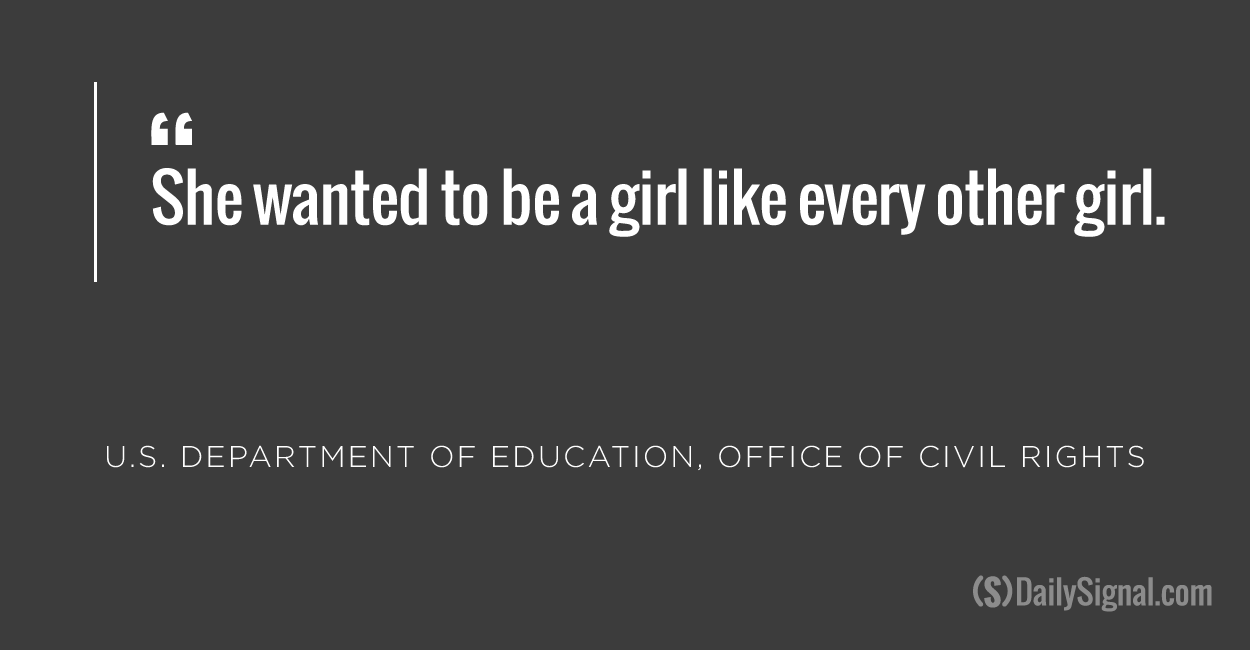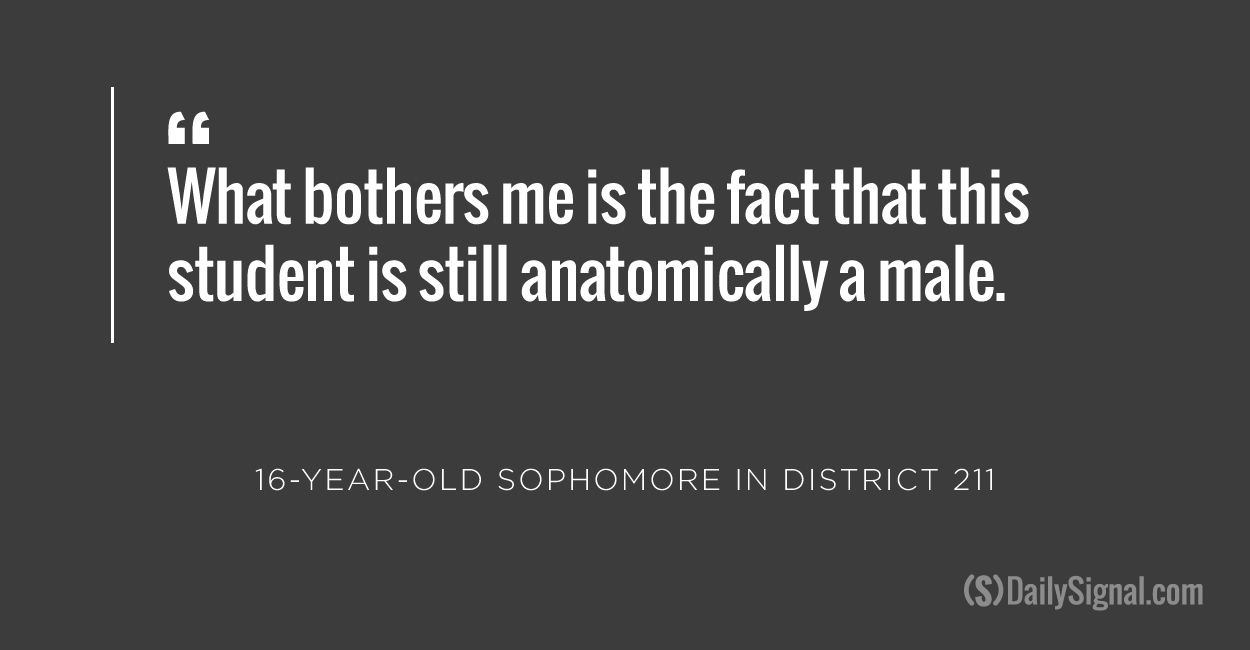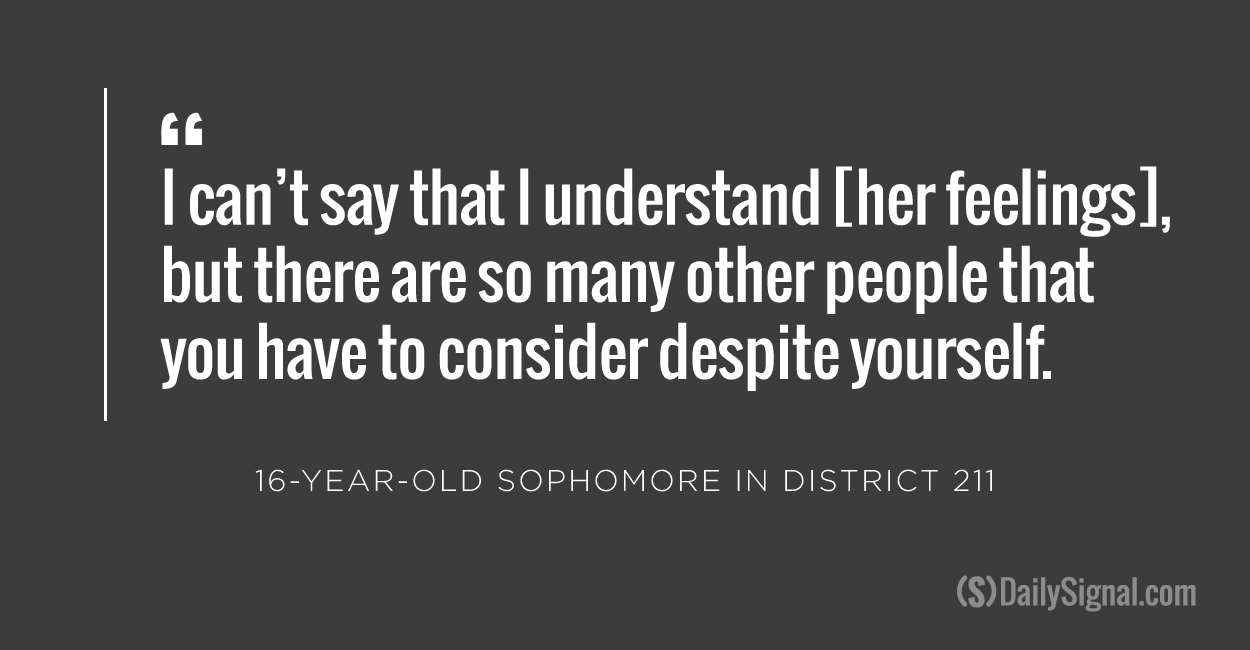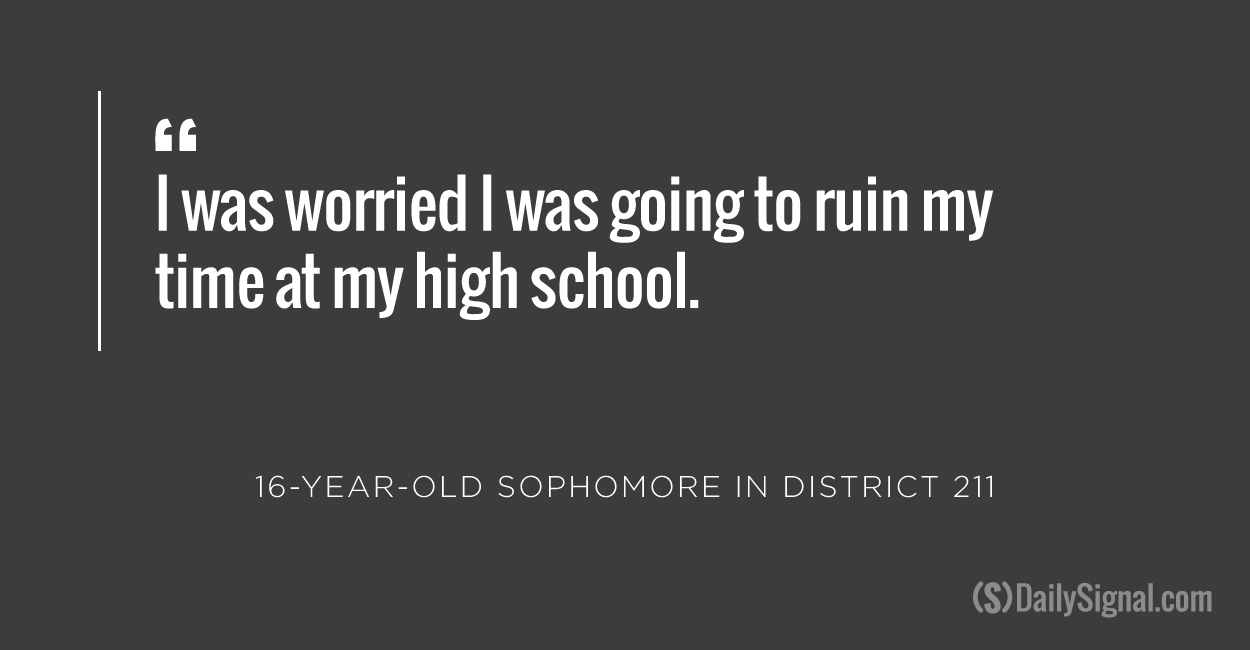Speaking out, they knew, could make them the public face of a very private issue.
It could lead their classmates to call them “bigots,” “insensitive,” and “homophobes.”
But after seeing their high school back down to threats that the U.S. Department of Education would strip away federal funding, and watching school officials overrule their parents, a group of six high school girls in Cook County, Ill., decided to speak out.
On Dec. 7, before a crowded school board meeting packed with news media, they would tell the world why they don’t want a high school student who was born male, but identifies as a female, to use the girls’ locker room.
They would tell the world why allowing a transgender student to see them in a state of undress would be an invasion of their personal privacy.
They would explain why, at 15 and 16 years old, changing alongside biological women is already hard enough.
“It is unfair to infringe upon the rights of others to accommodate one person,” the six girls, in a joint statement, told an audience of at least 500.
“Although we will never fully understand your personal struggle,” they said, addressing the transgender student, “please understand that we, too, all are experiencing personal struggles that need to be respected.”
Palatine, a well-off suburb of Chicago, is the first district in the country to be found in violation of civil rights laws on transgender issues.
By forcing the transgender student—known in the media as “Student A”—to use a separate locker room, the Department of Education’s Office of Civil Rights ruled that Township High School District 211 had discriminated against the student “on the basis of sex.”
The finding came as the result of a lengthy investigation, triggered by a lawsuit filed by Student A’s parents.
To resolve the findings—and to avoid the Department of Education’s threats of losing federal funding—the school board changed its policies to allow Student A into the girls’ locker rooms, so long as the student changed behind newly installed “privacy curtains.”
Those curtains, the six girls said, shield Student A from personal insecurities, but they leave the rest of them uncomfortably exposed.
‘Still Anatomically a Male’
According to the Department of Education’s investigation, Student A began transitioning to a female in middle school.
The student was diagnosed with gender dysphoria and currently receives an “ongoing course” of hormone therapy.
But some girls at the high school say Student A has not fully transitioned, which makes some of them uncomfortable sharing a locker room.
“What bothers me is the fact that this student is still anatomically a male,” a 16-year-old sophomore told The Daily Signal on the condition of anonymity. “If the student had already undergone surgical procedures, this would be another story entirely, but as it stands I just don’t feel comfortable with it.”
A 15-year-old told The Daily Signal “it just doesn’t feel right.”
“I know Student A poses no harm to me, but it just doesn’t feel right knowing someone with male anatomy is in the bathroom with me,” she said, adding:
I have nothing against Student A and would be her friend if I knew her better, but when it comes down to it, I don’t feel right changing in the same room as a transgender student. The locker room is already filled with so much judgment, and I barely feel OK changing in front of my naturally born girl peers.
A third student, a 16-year-old sophomore, expressed frustration.
“[W]e are supposed to accept this and feel like nothing really is happening, but the fact of the matter is that this did get pretty big and now we have someone with male genitals in our girls’ locker room when we are changing,” she said.
The Daily Signal spoke with five girls who attend the same high school as Student A, four of whom oppose the student’s use of their locker room and one who supports it.
The Daily Signal also spoke with parents and the state chapter of the American Civil Liberties Union, which represents Student A in the lawsuit.
What became clear is that neither side is pleased with the final agreement the district reached with the Department of Education’s Office of Civil Rights, suggesting that public schools are not sure how best to deal with the difficult issues surrounding transgender students’ use of gender-specific facilities.
Privacy in the Locker Rooms
The Department of Education’s investigation into alleged discrimination found that “the district honored Student A’s request to be treated as a female in all respects except her request to be provided access to the girls’ locker rooms.”
This included granting the transgender student “unlimited” access to the girls’ bathrooms and allowing the student to play on the girls’ sports teams.
In lieu of granting access to the girls’ locker rooms, the school at one point installed a bank of lockers in a private bathroom and encouraged the student to invite friends who were comfortable changing there to move their lockers. This was meant to avert Student A from being forced to change alone.
Student A wasn’t happy with the setup and sought equal access to the locker area because “she wanted to be a girl like every other girl,” the Department of Education’s report said.
But on this front, the school administration wouldn’t budge.
The school originally held its ground based “not only on Student A’s rights and needs, but on the privacy concerns of all students,” the Department of Education noted in its report.
That all changed Nov. 2, when the school received the report saying if it did not change its policies to allow Student A into the girls’ locker rooms, the government could suspend or terminate the school’s federal education funding for violating Title IX regulations.
Title IX is the federal law that bans discrimination on the basis of sex in any federally funded education program. Experts disagree whether the law applies to transgenders’ use of separate facilities, although courts in Pennsylvania and Virginia ruled it does not.
Both those cases are being appealed.
To avoid charges of discrimination, District 211 reached an agreement with the Department of Education’s Office of Civil Rights. In it, the school promised to provide Student A access to the girls’ locker room throughout the duration of the student’s time there.
According to the National Center for Education Statistics, District 211 receives more than $5 million in federal funding each year.
The federal agency and Illinois school district reached the deal “based on Student A’s representation that she will change in private changing stations in the girls’ locker room,” the report said. Since Student A’s use of the privacy curtains is non-binding, legal experts say it is not clear what would happen if the student decided to change out in the open.
But even if Student A does abide by the arrangement, those who oppose the student’s use of the girls’ locker rooms say they’re still uncomfortable with the settlement.
“When she’s walking in and out of the privacy curtain, what happens when you’re in a state of undress?” a sophomore on the lacrosse team asked rhetorically, adding:
Then she is fully exposed to everything in the locker room. That was my main concern with the privacy curtain. It’s not like there’s a curtain around her face, it’s not like she’s not looking at everything around her.
To accommodate girls who “wish to be assured of privacy while changing,” the district agreed to install additional private changing stations inside the locker rooms.
Those critical of the compromise say the school is giving Student A “special treatment.”
“I will always be respectful to Student A and will treat her like I would anyone else I know,” the 15-year-old sophomore told The Daily Signal. “We all have to deal with inconveniences that we have to deal with, and I don’t feel as though someone should gain special treatment over me and all other naturally born girls.”
“I can’t say that I understand [Student A’s feelings], but there are so many other people that you have to consider despite yourself,” another student added.
When the school board voted 5-2 in favor of the agreement, members made clear that the deal applies only to Student A and is not a district-wide policy.
To accommodate Student A during off-campus sporting events, the Department of Education will require District 211 to provide access to girls’ locker rooms “in a manner consistent” with the home high school.
If locker rooms don’t already have them, this could mean installing privacy curtains inside all those locker rooms.
‘It’s What’s on the Inside That Counts’
Lauren Gregory, a 17-year-old attending the same high school as Student A, sees the situation differently. Gregory, who had no qualms going public with her name, said she believes those against Student A’s use of the girls’ locker rooms are more concerned with the “principle of being transgender rather than the locker room thing.”
“I know a lot of people are talking about privacy, and there’s been a lot of talk about anatomy … [but] the things that we value most in life are not physical,” Gregory said, adding:
Everyone tells your kids when you’re growing up, don’t worry how you look, it’s what’s on the inside that counts. I think I really carry that with me still, and I think that if someone feels a certain way and they feel like they’re in the wrong body, then I don’t have a problem with it. I think they have the right to become whoever they should be.
Gregory agreed that girls already feel uncomfortable changing in the locker rooms—some even change in bathroom stalls to prevent other girls from seeing their bodies, she said.
But Gregory believes that transgender students face similar insecurities and therefore are “not going to flaunt it or use it for bad things.”
“I know that these people who want to change their gender, they truly do not like the way that they are—the way that they were born—they don’t like the anatomy that they have, and they’re not going to flaunt it or use it for bad things,” she said. “They don’t even want it. They want to change it.”
‘Lynching the Board’
The ACLU of Illinois represents Student A in the lawsuit against District 211.
In an interview with The Daily Signal, Ed Yohnka, director of communications and public policy for the organization, said the girls who spoke out deserve “a lot of credit” for attempting to be “sensitive and yet show their concerns the best way they could.”
However, Yohnka said, “The concern that is being raised on the part of these students is not the concern that actually arises in the use of the locker rooms.” He suggested that girls don’t fully disrobe for physical education and sporting events.
“This is not an instance in which she intends to be immodest or provocative in any way, shape, or form,” Yohnka said of Student A. “If one actually reads the findings from the [Department of Education’s Office of Civil Rights], what they reveal is that, despite the reputed claims of the administration, students don’t fully disrobe in the locker rooms that she’s seeking access to.”
Multiple girls who spoke with The Daily Signal disputed that, saying they undress in the locker room for various sporting events, including lacrosse. They added that most sports teams share the same locker room.
“It’s a misguidance people have about high school girls not changing their entire clothes,” the lacrosse player said.
.@ACLUofIL Director of Communications and Public Policy Ed Yohnka speaks in support of Student A #WeStandWithHer pic.twitter.com/lFRQPeKszb
— ACLU of Illinois (@ACLUofIL) December 8, 2015
Students say showering hasn’t been an issue in this case because of the way the PE and sports programs work, although the school has a swim requirement that could affect future cases.
The ACLU’s Yohnka said the concern about Student A’s anatomy is simply “hysteria” created by the school administration.
“This administration has gone on television and talked about our client’s anatomy,” Yohnka, criticizing the school’s decision to go public with the negotiations, told The Daily Signal. “If they had done this to any other student in this district, the parents would be there lynching the board.”
Reached by The Daily Signal, a spokesman for District 211 officials said they would let previous statements and actions speak for themselves.
In October, when Superintendent Daniel Cates went public with the complaint filed with the U.S. Department of Education’s Office of Civil Right, he put out a statement defending the administration’s original position of limiting Student A’s access to the girls’ locker room.
In a message published in a newsletter, Cates wrote: “District 211 has supported—and continues to support—transgender students and their families while always balancing the rights and concerns of all students we serve.” (The full message is below.)
Some parents in District 211 told The Daily Signal that the school should have made the complaint public earlier than October so that the community could have been more involved in the school’s formulation of policy.
“We just want to decide this as a community first, instead of just quickly responding to the government, who has no business telling us what to do at a local level, especially on this,” Vicki Wilson, a mother of a sophomore, told The Daily Signal.
Wilson has been active in the debate and is a member of the group D211 Parents for Privacy.
Yohnka suggested that the ACLU would have preferred that the school administration had reached a final agreement with the Department of Education before making the dispute public.
“I’m not denying for a moment that they shouldn’t have shared a resolution, but I think there’s a way to, first of all, reach a resolution first,” Yohnka said. “At the time that they had made their announcement, they were still negotiating with [the Department of Education.] … It created this frenzy around all this as opposed to simply announcing we’ve reached a settlement, this is what it is, this is what it entails and really being prepared to do the educational piece.”
He added:
One of the things they might have thought to do was to use this moment as an opportunity to educate everyone involved in the community, in the school, et cetera, about these particular issues, but of course instead they decided to go out and engage in what really was a cynical public relations campaign in which you had a grown man on television talking about a young woman’s body.
The dispute is far from over, and if another transgender student comes along, the high school might have to address the situation again.
“The school district says at the end of the day that they’re still going to limit unfettered access to locker rooms based on anatomy, which fundamentally still misunderstands the notion of what it means to be transgender,” Yohnka said. “The anatomy in some ways scientifically is the least important indication of gender identity that there is, and yet they seem to be relying so heavily on it.”
To avoid facing the same problem, lawmakers in Illinois are considering addressing the issue at the state level.
“This is a push by the federal government to bully local units of government into adopting these kind of policies,” Illinois state Rep. Tom Morrison, a conservative Republican who has three children in the area, told The Daily Signal.
“This patchwork of policies is making it very confusing for parents and students and visitors to these schools,” Morrison said. “It would be helpful to have some guidance and guidelines that establish clear boundaries for bathroom and locker room policy.”
Emergency Meeting
In early December, the District 211 school board called an emergency meeting to reconsider its decision to change its original position and instead allow Student A full access to the girls’ locker rooms.
The meeting drew a large crowd, with students and parents telling The Daily Signal that people came from all over the state.
December 7th, 2015, District 211 School Board public forum for a new Transgender policy.
Owen Daniel-McCarter:… https://t.co/fTvKb1xt8L
— Illinois Safe Schools Alliance (@ILSafeSchools) December 9, 2015
Sources attributed the high attendance to groups such as the ACLU that advocate on behalf of transgender rights. Before the meeting, those groups sent out press releases telling members their support was needed. One ACLU press release read:
There were many supportive voices at the board meeting last week. However, the opponents to fairness made up the majority of speakers. We’d like to see more supporters turn out on Monday and could use your help. If you are able to attend or otherwise want to help out, please email us.
We owe special thanks to everyone who came Mon. night to stand up for Student A #WeStandWithHer #twill #transgender pic.twitter.com/vkAxYM5ib9
— ACLU of Illinois (@ACLUofIL) December 10, 2015
Parents and students said they were frustrated to see the situation evolve from addressing the specific situation of Student A to a larger debate on transgender issues.
“It was kind of sad to see a bunch of people who didn’t care about the student; they just cared about getting their own agenda in place, and then they left,” the sophomore lacrosse player told The Daily Signal.
“It was very interesting to see,” she added. “It was very eye-opening about the world of politics.”
That day, the sophomore didn’t just learn a lesson in politics. She learned that speaking out about sensitive issues didn’t have to be so scary.
“I’m only a sophomore … my face will forever be known as the one who spoke out against Student A,” the student said of her concerns for the future. “I was worried I was going to ruin my time at my high school.”
When asked what she was so worried about, she said she and her friends feared being called “bigots, insensitive, inhumane, discriminatory, homophobic.”
“There are so many,” she said of the labels.
But to her surprise, school the next day was largely the same. Those who disagreed with her comments still treated her with respect.
“Disagreement is not discrimination,” she said.
I think that’s something that’s important for adults to recognize—that we need to be loving and concerned and care for each other even if we don’t agree sometimes.




































